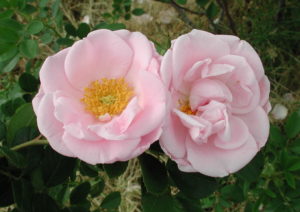The Rose Genetics & Breeding Program
Breeding Disease Resistant Roses
Roses are among the most important ornamental crops worldwide. According to the United States Department of Agriculture’s 2019 Census of Horticultural Specialties, the overall value of cut roses sold in the United States, which includes hybrid tea roses, spray-type roses, and sweetheart roses, was ~$10 million. Meanwhile, the roses sold in the US as shrubbery numbered ~25 million and were estimated to be worth ~$168 million. There are more than 20,000 commercial rose cultivars in circulation, most of which are complex tetraploid or triploid hybrids derived from eight to ten wild diploid and a few tetraploid rose species. Rose breeding has predominantly focused on the specific ability to produce cultivars with the desired combinations of color, form, fragrance, and hardiness.

The greatest dangers for cultivated roses in the world are disease pathogens and insect infestations. Pathogens and pests in commercial roses are generally controlled with pesticides, often at substantial expense to the grower. As a result, the incorporation of particular resistances to rose genotypes, especially to the black spot fungus (Diplocarpon rosae. [Lib.] Wolf), powdery mildew (Sphaerotheca pannosa Wallr. [ex Fr.] Lev), rust (Phragmidium spp.), Cercospora leaf spot (Cercospora spp.), and rose rosette disease caused by the Rose rosette emaravirus, is greatly desired.
For the last 200 years, rose breeders have made tremendous advances, and a rainbow of colors and a wide spectrum of flower and plant forms are available. We owe much to those who created this cornucopia of beauty. However, extensive research remains to be done. Little sustained effort has been devoted to developing plants with resistance to diseases and pests.
The Rose Genetics and Breeding Program uses a multidisciplinary team to combine the sciences of genetics, cytogenetics, breeding, plant pathology, entomology and plant physiology with genomics tools. The main objective is to develop unique sources of disease-resistant germplasm and germplasm for the rose community.
For more detailed information from the USDA Census, please refer to the USDA’s 2019 Census of Horticultural Specialties (this link opens in a new window).
